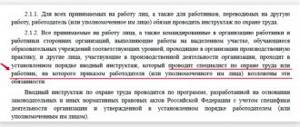Home / Labor Law / Employment / Personnel adaptation
Back
Published: 07/22/2016
Reading time: 9 min
0
1776
Effective, successful adaptation of a hired or transferred employee to new working conditions is one of the most important indicators of the effectiveness of an organization’s personnel management.
The implementation of adaptive programs is designed to facilitate psychological, psychophysical, professional, socio-economic adaptation, and the integration of a newcomer to the existing production environment.
- Purpose of personnel adaptation
- Responsible for adaptation
- Stages of developing an adaptation program
- Program structure
- Tips for writing
- Examples of adaptation programs For chain store sellers First day
- 2-7 days
- 8-10 day
- 11-14 day
- 15-21 days
- 22-30 day
- 1st week
What is personnel adaptation
Everyone is faced with the need to get a new job and join the team.
This process in the language of labor legislation is called labor adaptation. The faster the staff adaptation process goes, the easier and more logical it will be for a new person to join the workforce. Otherwise, a person who lingers in the habituation phase will not be able to establish relationships with the work team and will subsequently become an outcast among his colleagues. The situation, of course, depends on the employee himself, on his ability to find a common language with other people, build relationships with colleagues, on his professional knowledge and skills, and the level of his psychological preparation.
Successfully completed professional adaptation of personnel indicates a high level of moral and material reward in the future, receipt of social recognition and other benefits.
Goals and objectives of personnel adaptation in the organization
Organizing the management of career guidance and personnel adaptation is the work of the personnel department and the head of the department where the new employee works.
Adaptation is an important point in personnel management, which determines which personnel will work in the organization, what the psychological climate in the team is and how well and productively employees will perform their duties.
The goals of the work on adaptation of new employees are:
- accelerating the process of introducing a new employee to the job, familiarizing him with his job responsibilities;
- complete elimination or reduction of staff turnover in the organization;
- motivating employees to be interested in the result, to be motivated to perform their job duties better, and to give maximum return to their work;
- increase in labor productivity;
- improving the psychological climate in the team.
Only taking into account all the listed factors and working in this direction will give the best result.
Stages of developing an adaptation program
The development of a personnel adaptation program involves going through the following stages:
- collection of information about vacancies, qualification requirements for candidates;
- studying the conditions, state, prospects for the development of the labor market, the work of educational institutions that train the professional personnel necessary for the enterprise, offers from employment services, labor exchanges, and recruitment agencies;
- analysis of the current adaptation system in the organization, its effectiveness;
- familiarization with the laws and regulations governing the adaptive process (provisions on the probationary period and adaptation of employees, internal instructions on mentoring, instructions on conducting interviews);
- development of adaptation measures, questionnaires for interviewing, interviews, selection of tools for psychological and professional testing,
- determining the duration of the program (short-term, lasting up to 1 year, up to 3 years);
- selection of employee categories (young professionals, qualified personnel, middle managers, top managers), program structure, direct participants in the adaptation of a particular employee;
- meeting a new employee, collecting information;
- development of criteria for assessing the success of the adaptive program and the possibility of its correction.
Stages of personnel adaptation
Adaptation of personnel at an enterprise is a delicate and multi-stage process. Each organization has a program and its own developed approaches to solving this issue.
But all possible stages of personnel adaptation can be divided into:
- Primary (preparatory). After hiring a new employee, the manager introduces him to the rest of the team. Introduces the employee himself to his new workplace, appoints a curator (a more experienced employee who will help the newcomer at the beginning of work), and completes the preparation of all necessary documents. This stage may include familiarization with the history of the enterprise, its structure, mission, products, procedures, and rules of corporate ethics.
- Theoretical (training). At this stage, the employee is introduced to the theoretical part of his main job, functional responsibilities and requirements for further work performance.
- Practical (application of knowledge). Directly performing some practical tasks: first under the supervision of a mentor, then independently.
- Final (passing the probationary period). It consists of summing up the work of the new employee. It is assessed how successfully he settled into the new team, managed to master new skills, and integrated into the team. At this stage, the employee’s strengths and weaknesses, his successes and failures are already visible. Based on everything taken together, management makes a decision on its future fate. Whether he passed the test and will continue to work or not, and the company no longer needs his services.
Based on the foregoing, one can understand how labor adaptation of personnel is an important and serious thing, and that this is one of the indicators on the basis of which a decision is made whether the applicant will remain in the organization or will look for work elsewhere.
One-on-one feedback on time blocks
Let's take a closer look at each time block separately.
First week. Personal assessment and goals
Two ratings
. After the first week of work, provide two assessments: your personal assessment, as your immediate supervisor, and your mentor's. Talk about everything you like and don’t like about the process of going through the checklist and completing the initial work.
I give all newcomers who come to my teams a simple instruction: a good newcomer “bombs” everyone with questions.
A beginner who doesn’t ask questions is, at best, doing nothing, and at worst, doing something wrong.
At this moment, I once again tell him to address questions to his mentor, manager and colleagues as often as possible, because this will involve him in the adaptation process even more. Goals
.
Remember the goals you need to achieve in order to successfully complete the probationary period. If during the probationary period there are clearly formulated goals and criteria for their implementation
, then the stress level of the new employee will be an order of magnitude lower than in a situation where he does not understand until the last day whether he has passed the probationary period or not?
Discuss goals and criteria at the first orientation meeting
, but not on the first day of work. On the first day, a newbie is interested in questions at the level: “Where is the dining room, where is the restroom, how to get into the tracker?” After the newcomer has caught his breath for a week, talk through the goals so that he understands where he is going, how many “levels” and “bosses” are ahead.
Second week. Unit assessment
Feedback from the department
. You evaluate the employee and give him feedback not only from yourself, as a mentor or manager, but also collect material from the department in which he works.
Don't separate yourself from the team
. This is especially important. As a department manager, report news exclusively with a “We think you're doing a good (or bad) job” attitude. The approach when the manager gives his opinion, and then separately mentions that the team does not think so, creates the impression that the boss is good, and someone in the team is plotting.
When you collect feedback from employees within the department, choose one of two options. In the first option, you take the side of the team - collect negative reviews along with arguments. In the second, you break down the negative if you don’t agree with the team’s opinion and explain why. But don’t separate from the team, come to a common opinion.
First month. Assessing colleagues from other departments and moving towards goals
Evaluation from other departments
. It is logical to assume that in the first 2-3 weeks a person will work more within his own team on small routine operations that allow him to be involved in work within his department. By the end of the first month, he will be more closely integrated with external teams. At this time, other teams and departments will form an opinion about the new employee, which you can gather.
Protect your employee's interests
. You can’t oppose yourself to other teams: “In testing, we think you’re great, but in development, we don’t.” This creates a bad atmosphere between teams. The situation is similar to collecting feedback within your own department: you either agree with the thesis that was brought from outside, or challenge it. You cannot divide and demarcate responsibility for feedback.
Goals
. In the first month, you return to the goals of the probationary period and help set specific immediate steps to achieve them. It is at this moment that a person is most ready to master the basic tools, gain access, perform standard operations, integrate into teams, and meet the right people. It can begin to “light up” precisely at the monthly mark.
Second month. Evaluation of team leads of other departments, first warning
Feedback from team leads of neighboring teams
. The newcomer has already worked with entire groups. Most likely, the team leads have formed some kind of idea about him. It is important to collect team leaders’ opinions about the employee and give the person the opportunity to feel that his appearance is noticeable in the company and causes a reaction: positive or negative.
The second month and the feedback meeting are the perfect moment for the “last Chinese warning”
. Tell the employee about his “jambs”: “If you continue to do A, B and C and don’t start doing 1, 2, 3, then you will not pass the probationary period.” If you talk to him correctly, at the end of the third month the person will have no questions whether he passed the probationary period or not.
The transparency achieved through the checklist, among other things, allows the employee to reduce the level of stress during adaptation.
Third month. Results of the probationary period and achievement of goals
Summarizing
. The newcomer goes through a probationary period, you sum up the results, talk about goals. It’s great if the goals are not templates, but formulated according to SMART: specific, time-limited, measurable and relevant.
Talk about good things
. As a leader, broadcast positivity on behalf of the company. When a person reaches the culmination of the probationary period, mark it with approval and positivity. Tell us where the person showed himself successfully, how many and what tasks he completed during the probationary period, and summarize.
Praise
. After completing the probationary period, be sure to praise the employee. There are big problems with this in Russian culture. I get the impression that when we are all born, we are given 3 freight trains of criticism and a glass of praise. Therefore, we think - to praise or not? Should you spend a little praise today or save for next year?
A successful example of adaptation
Adaptation of personnel in the organization, using the example of one of the companies, occurred as follows. More experienced employees were assigned the role of mentors. The employee in charge of the newbie onboarding system downloaded data from the accounting system daily about people who needed to return to work soon. Each person was manually assigned a different mentor. They had to work in pairs. Mentors were selected from any department, except the one where the newcomer would work in the future. It is more convenient to work in pairs, taking into account different workload schedules, and it is easier to communicate with strangers. Once mentors were approved, automatic notifications were sent to them, and a reminder was added to the calendar about the day the new employee would start.
The day before, the mentor called the newcomer for correspondence acquaintance and so that in the future the newcomer would contact him upon arrival at the office to meet and discuss work issues. The mentor must check whether everything is ready to accept a new employee, make sure that the workplace is organized, and remind the head of the department where the newcomer is getting a job about the new employee’s departure.
On the first day, a pair of mentors meet the new recruit in the morning, talking about the available information on the corporate portal. This takes a couple of hours. This meeting makes it clear to the employee that he was expected. On all other days, if questions arise, he can contact his mentors, ask them questions to solve any situation, from a broken chair to a conflict situation with another colleague, and they help resolve them. At the end of the probationary period, the employee must evaluate the work of the mentors and their assistance. Mentors are awarded points for this, which subsequently affect their financial incentives.
Checklist cornerstones
These are the moments that determine its structure: publicity, time blocks, clear performance criteria, mentor and feedback.
Mentor
A mentor is attached to the checklist
. This is a guide for a new employee in the company, without him there is nowhere. Sometimes it happens that the immediate supervisor becomes a mentor. But when the team has 10-15 people, the manager will spend an excessive amount of resources on mentoring.
The manager does not have to become a mentor to the newcomer.
Mentoring does not require managerial competencies.
A basic understanding of what and how the company works is enough. If you are a leader, delegate mentoring
. Find empathetic people within the team who are interested in additional people and resources and involve them. They will do a better job than you. For example, like in Mail.ru Group. The company has a whole institute of mentors - a separate caste with its own training. There, the title of “mentor” is honorary.
Publicity
The checklist is public
. Imagine an unhappy newcomer: he is stressed, trying to understand what is happening, does not understand where to grow and what to do within the company. HR or the team lead walks around him, looking sideways and checking off some kind of “checklist”. Absurd? Of course, this is why the checklist is available to both the mentor and the employee. Now at FunCorp we use a practice where the checklist is public and in relation to the team.
Public access increases the level of responsibility of the mentor and the newcomer
. When the entire team sees the progress of a new employee and his path along the checklist, the mentor’s responsibility increases by an order of magnitude.
Involves the mentor and team in the passage
. Here the team is not a supervisor, but an assistant. If someone sees that there is no question about traditions in the checklist, one of the colleagues can say about this: “We have a tradition - every new person is marked with beer on Fridays!” This may be fiction, but this is how he participates in the adaptation of a new employee.
This involves not only one mentor and immediate supervisor, but also the entire team. This is good psychological support for a new person. He understands that these are not isolated people who look askance and tick some boxes, but a team that supports him.
Time blocks
Decompose and conquer
. The checklist is divided into blocks: first week, second, first month, second and third. Inside the checklist, these timelines allow you to break down the footcloth into a list of tasks. It will be strange if, as part of adaptation, in the first week a person tries to understand a complex tool that will only be useful in the third month of work.
The opposite also works - why wait until the third month to familiarize yourself with the restrooms in the office? Although I came across such a situation a couple of times when it was only upon request. The issue of the restroom was a closely guarded secret: no one showed or told, at home you go to the toilet before and after work, but at work you endure it, or try to find out from someone where this “office” is.
Clear chronology of adaptation
. A newcomer goes from simple to complex: first traditions and the product, then he gets to know his product team, then gets the necessary access. When everything is completed, a full-fledged employee is ready, who performs a certain layer of work.
Definition of Done
Obvious and understandable criteria for completing the task
. This is important - it helps to assess that the item has really been completed and the box has not been ticked “for the sake of a box”.
Sometimes there is a temptation between a mentor and a newcomer to enter into a “criminal conspiracy”, to mark an item on a checklist without checking.
- You need to familiarize yourself with some regulations - I saw a list of regulations somewhere in Confluence. I guess I got to know them.
The mentor also thinks:
- Well, I got acquainted, that means I got acquainted.
You shouldn't do that.
During a one-on-one meeting and gathering feedback, I recommend sifting diagonally through the checklist items
. For example, if an employee has sorted out tickets in the tracking system, ask him about key statuses. If you have installed and configured the tool to work, make sure that this is indeed the case. Sifting helps clarify the reality of completing items.
I do not recommend arranging checks like on an examination committee
. You can reach the point of insanity: “Let’s sit down and you will slowly show how you figured out the point of going to the restroom.” Be gentler, remember that you took not a junior, but a professional. He realizes that the checklist is a “guide map.” The employee understands that his own success in the company depends on honest performance. If he is deceitful, he will deceive himself, and not his employer.
One-on-one feedback
At the end of each block
we have one-on-one meetings to get feedback.
Checking the checklist to find out which items have been completed
. Ideally, by the end of the reporting period, all items should be completed. This is an indicator that the new team member has acquired the necessary knowledge, skills and competencies.
This is also a good opportunity to talk to a person
about what he likes or doesn’t like about the job, the team, and the company. In my experience, when newcomers come to the company, they all say that they like everything. Sometimes it’s euphoria, rose-colored glasses, but often it’s fear for one’s future fate. The man thinks that he will be fired if he says that Petya is a bad manager. Therefore, he remains silent, suffers, leaves during the probationary period, but Petya remains. Only at the exit interview do we find out that the newcomer did not want to work with the manager.
Be sure to collect "negative"
. While collecting feedback, go deeper and offer options: “Maybe you don’t like the process or something in the office. Perhaps they are not satisfied with our orders and traditions?” It is the “fresh” people in the company who have an uncluttered view. They will highlight problems that you no longer see because you are used to it or “historically”.
Provide feedback
. You should do this too - indicate what the person does well and what he doesn’t, what the problems are, how to adjust his behavior or qualifications.
Personnel adaptation methods
The research program for the personnel adaptation system identifies the following forms of personnel adaptation:
- mentoring (providing assistance at the initial stage of work by a more experienced employee through consulting, introduction, assistance in getting to know the team);
- attending trainings and seminars (training and developing certain employee skills, for example, communication, public speaking skills, preparing presentations, developing stress resistance, etc.);
- conversation (an introductory conversation between a newcomer and a HR manager, supervisor, or HR department employee, during which the employee receives answers to his questions);
- a specialized program (for example, educational films or team role-playing games aimed at team building);
- excursion (sightseeing tour of the organization, its structural divisions, territory, familiarization with the history of the company, employees, corporate culture);
- request for feedback (at the end of the period of adaptation and completion of the probationary period, the employee is asked to fill out a feedback questionnaire);
- other methods (corporate events, certification, testing, training, etc.).
Program structure
The program is designed to describe in detail the goals and objectives of the adaptation period. Indicate the duration and responsible persons, sequence of activities, forms and methods of influence, expected results, forms of control.
The adaptation program has its own characteristics depending on the status, rank, degree of responsibility of the employee, his individual psychological and physiological (health status, threshold of fatigue) characteristics, the specifics and content of production, established intra-production relations and traditions and includes mandatory and variable sections.
Required items include:
- Getting to know the employee (interview, interview, testing).
- Familiarization with job descriptions, regulations on internal regulations, social benefits, remuneration, system of fines, types of insurance, career opportunities, terms and conditions of employment.
- Instruction on safety precautions, fire safety, familiarization with evacuation schemes, location of the medical center, canteen, household, sanitary and hygienic premises, parking of personal vehicles, means of communication.
- Introducing the newcomer to the team, management, and supervisor.
- Evaluation of the employee, confirmation in position or dismissal based on the results of the probationary period.
The variable part may include:
- Plans for the first working day, week, month. Daily communication in order to clarify and eliminate emerging problems, misunderstandings of specifics, encouragement and motivation for success during the week or month.
- Acquaintance with the organization in the form of a welcoming speech, presentation ceremony, excursion, welcome training, information booklets, films giving an idea of the products, the purpose of the company, its development prospects, history, corporate charter, priorities, structure, corporate slang, traditions, dress- code, “unwritten” laws, established collective relationships.
- Help in organizing the workplace.
- Assessment of professional competence.
- Organizing feedback with a new employee (questionnaires, individual conversations, collecting feedback from colleagues, managers, mentors, individual adaptation cards, personograms).
- Trainings, role-playing games for team building, formation of group relationships, dynamics.
- Participation in the social life of the team, informal communication, performing one-time social assignments, participation in managing the work of the team, trade union work, getting to know the newcomer’s family.
- Additional training, internship, intermediate instructions, involvement in production competition, corrective measures and procedures, gradual complication of professional tasks.
- Intermediate monitoring of the adaptation period, preliminary analysis, personal characteristics.
Types of personnel adaptation
Adaptation can be of the following types:
- professional involves learning new special skills, acquiring a new one or improving an existing skill or professional skill. This type depends on the desire and ability of the beginner to learn, the desire for new knowledge, and his ability to learn. This also includes preparing the workplace and providing all necessary materials;
- socio-psychological implies a person’s adaptability to work in a new team, under the leadership of a new boss, submission to the traditions, norms and rules of behavior that have developed in the organization;
- organizational is based on the employee’s understanding of what is required of him, working with job descriptions, determining his place in the structure of the enterprise, and participation in the production process.
Only an integrated approach to professional and psychological adaptation leads to the successful completion of the probationary period by the employee and saves the company’s costs on searching, training and evaluating personnel.
Key elements of the personnel habituation system
Webinar “Welcome!”
Regular online presentation providing the employee with an initial introduction to general information about the Company, its history, products, services, structure and culture.
Induction Matrix
A set of training programs and materials developed based on a synthesis of best practices for a specific group of positions.
Workplace habituation program
A structured action plan that helps the employee adapt to the team, and determines what and in what sequence the employee will learn, and what duties he begins to perform first.
Mentoring system
A set of procedures for selecting from among experienced workers and appointing a mentor to provide comprehensive assistance to a newcomer who has begun his professional development in a new position, in a new company, during the period of his training.
Goals of the mentoring system:
- ensure the speedy adaptation of a newcomer to a new workplace and the achievement of optimal performance indicators for the position held;
- optimize the Company’s costs for recruiting and training personnel;
- reduce staff turnover by reducing the number of employees who left the company during and immediately after the probationary period;
- optimize the time spent by department heads on training and assessing new employees.
HR support
A system of interaction between an HR partner and an employee, aimed at providing socio-psychological support to the employee and organizational support for the adaptation program.
Monitoring the effectiveness of the adaptation process
- Performed at a specified frequency or within a specified time frame;
- Procedures for monitoring the completion of internships;
- Measurements and evaluations of the results shown by the newcomer;
- Receiving feedback from the employee.
Current control is a periodic check of the implementation of the activities provided for in the Adaptation Program. Performed by the HR partner at least 2 times in the first month and 1 time in subsequent months of the adaptation period.
Evaluation of results - conditions and procedures that provide clear and understandable criteria for the employee and a procedure for assessing the employee’s completion of adaptation measures.
Feedback - Tools and procedures that ensure documentation of employee satisfaction with the quality of adaptation, identification and analysis of the causes of problems in the processes of personnel adaptation.
What does the adaptation program consist of?
An employee adaptation program is a plan for introducing an employee to a position. This document is needed to apply a uniform approach to the adaptation procedure across departments of the organization. The document is an extensive list of actions for the adapting employee and for his supervisor, who will help adapt to new working conditions.
For an employee, the most difficult period is the first two to three months, which usually coincide with his probationary period. Often the duration of the program is equal in length to this period.
An optimally formed program is characterized by the following features:
- clear planning;
- clear content;
- strict distribution of roles and tasks.
The document consists of two parts: general and individual.
The approximate structure is as follows:
1. The general part, which helps to form a general idea of the enterprise, its features, hierarchy, established relationships between departments, distribution of functionality, working conditions, etc.
Comprises:
- orientation introductory conversation;
- personal acquaintance with the enterprise and personnel;
- getting to know the place where work duties are performed;
- orientation conversation with the manager heading the structural unit.
2. The individual part, which is formed by the immediate supervisor who supervises the induction of the employee. It is agreed upon with the head of the area of activity and the head of the HR department. This component helps the employee obtain detailed information about the activities of the organization and the direct functional responsibilities of the employee.
Comprises:
- inauguration plan;
- entry assessment plan;
- definitions of a curator-mentor;
- employee report on the results of work performed, information about ratings and feedback from mentors and supervisors.
Implementation goals
Adaptation programs in various companies are drawn up and implemented taking into account the specifics of a particular company.
Their main goal is to ensure an attentive approach to a new employee, creating the most comfortable and at the same time effective conditions for taking up a position.
A personnel adaptation program is needed so that the organization has a seamless, proven procedure for hiring employees.
Its main task is to quickly and easily introduce a newcomer to the course of business, familiarize himself with the team and job responsibilities.
An induction plan helps minimize errors, reduces initial discomfort and increases the employee’s skill level from the very first days.
What does the plan look like?
There is no single established algorithm for document development. The reason is the need to orient the document to specific conditions in the organization.
However, there are a number of features common to different programs:
- include several stages;
- have similar goals.
The plan includes the following items:
| Term | Actions | Involved personnel |
| Adaptation Day No. 1 |
| Human Resources Department Occupational Safety Specialist |
| Personnel adaptation week No. 1 |
| Head of department, mentor |
| Onboarding Month #1 |
| Head of department, mentor |
| Adaptation Months #2-3 |
| Head of department, mentor |
The result of a successfully implemented adaptation program will be an indicator of the duration of an employee’s work in a particular institution. The success of the adaptation procedure largely depends on the second party involved in the process - the manager or mentor. their desire to help the newcomer will help the latter get used to the organization as quickly as possible.
Organization of the adaptation process
This section describes approaches to organization, typical composition and content of the adaptation process. The frequency or timing of individual activities, the responsibilities of participants, and other details are defined in Appendix 1 “Personnel Adaptation Procedure”
Structurally, the adaptation program includes three mandatory blocks:
- Training activities and materials provided for this position;
- Assignments and tests to consolidate the knowledge and skills acquired by the employee during training;
- Practical tasks for the adaptation period.
Primary and secondary adaptation. There are two types of personnel adaptation procedures:
- Initial adaptation is carried out when hiring a new employee.
- Secondary adaptation is performed when an employee is transferred to a new position, with or without a change of profession.
- The type of adaptation is taken into account when developing an employee adaptation program.
Duration of the adaptation program and probationary period
The adaptation program is developed for the entire period of the probationary period provided for the position of the employee being adapted. The duration of the probationary period is determined by agreement of the parties when concluding an employment contract with an employee or when transferring an employee to a new position. The test period cannot exceed:
- six months - for positions of managers and chief accountants of organizations (branches and other separate structural divisions) and their deputies;
- three months - for other positions.
The period of temporary disability and other periods when the person was actually absent from work for valid reasons are not included in the probationary period. The probationary period may be reduced, at the request of the immediate supervisor, to a duration of at least one month, subject to full completion of training and achievement of the established minimum performance threshold. Failure by an employee to achieve the minimum performance threshold established for the adaptation program or its stage may be grounds for dismissal of the employee before the expiration of the probationary period. In this case, the company administration must notify the employee of dismissal in writing no later than three days before the date of dismissal, indicating the results of completing the adaptation program and/or other reasons that served as the basis for recognizing this employee as having failed the test. Thus, the results of assessing the employee’s completion of the adaptation program are the basis for making a decision:
- about the newcomer’s passing the probationary period (“passed the test”)
- about the newcomer’s early completion of the probationary period (“passed the test ahead of schedule”)
- about the newcomer’s unsatisfactory completion of the probationary period (“failed the test”)
- The decision is made by the immediate supervisor
- mandatory agreement with the mentor and HR partner.







